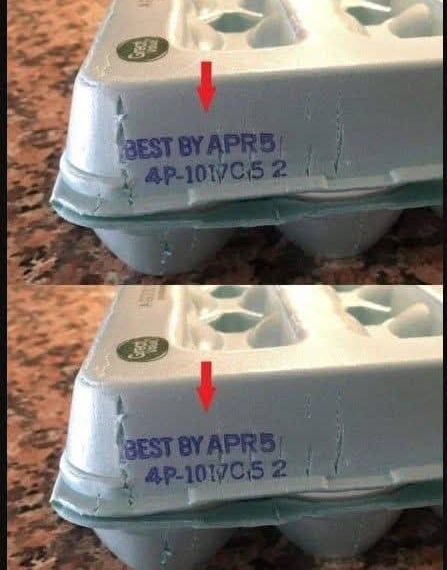Understanding the Hidden Code on Your Egg Carton
Have you ever glanced at your egg carton and noticed a string of printed numbers and letters under the “Best By” date? You might think it’s just packaging clutter, but it’s actually a valuable piece of information—and it’s not just an ordinary expiration date.
The image above highlights a subtle but fascinating feature of food packaging, particularly on egg cartons: a production code that can tell you exactly when your eggs were packed—sometimes more accurately than the “Best By” date.
Let’s break it down!
📦 The “Best By” Date – What It Really Means
Most people rely on the “Best By” date (like APR 5 in the image) to know when eggs expire. This date is a recommendation from the manufacturer or distributor about when the eggs will be at their peak quality, not necessarily when they go bad.
Important:
- The “Best By” date doesn’t mean the eggs are unsafe after that day.
- Properly refrigerated eggs can last 3 to 5 weeks after this date.
What Do the Numbers Below Mean?
Right beneath the “Best By” date is a strange-looking code:
4P-1017C52
At first glance, it may seem random. But here’s what it can tell you:
1. Julian Date (Packaging Date)
Often embedded within these codes is a 3-digit Julian date—a number between 001 and 365 that tells you exactly which day of the year the eggs were packed.
In this case:
- “101” refers to the 101st day of the year, which is April 10 (in a non-leap year).
- This means the eggs were packed on April 10, not April 5!
👉 So, how can the “Best By” date be before the packaging date?
Likely, the carton was reused or mislabeled, which does happen occasionally. This is why reading the full code matters.
🏭 2. Plant Number
The “4P” part of the code often indicates the plant number or processing facility. This is mostly useful for tracking where the product came from in case of recalls or quality checks.
3. Other Letters and Numbers
Codes like C5 or 2 are often internal identifiers for batch, line, or shift numbers, which help the company trace production in case of any issues.
✅ How to Use This Information
Knowing how to read this code gives you a real edge:
- Check freshness more precisely. The Julian date tells you the exact pack date.
- Spot mislabeled cartons. As seen in the image, the Best By date doesn’t always make sense alone.
- Avoid unnecessary waste. Many eggs are discarded because people misunderstand expiration dates. With this code, you’ll know they’re still safe!
🧪 What Do the Experts Say?
According to the USDA, eggs can be sold up to 30 days after the packing date, and if kept refrigerated properly, they are usually safe to consume for at least 3 to 5 weeks beyond that.
Also, the USDA requires all USDA-graded eggs to include the Julian pack date on the carton.
Final Thoughts
That line of text beneath the expiration date?
It’s not just filler—it’s a secret key to understanding your food. In a world where reducing food waste and increasing transparency matters, knowing how to decode it puts you one step ahead.
So next time you reach for a carton of eggs, take a closer look.
It’s not an ordinary expiration date—it’s an information-packed code worth cracking!





